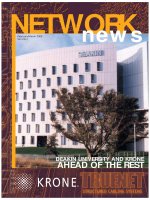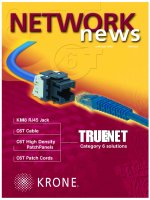Tài liệu ADC KRONE Network News - Vol.10 No.3 - 2003 ppt
Bạn đang xem bản rút gọn của tài liệu. Xem và tải ngay bản đầy đủ của tài liệu tại đây (1.22 MB, 16 trang )
Vol10 No3
K
RONE, globally, celebrated its 75th
anniversary recently. Seventy-five
years, in any industry is quite an
achievement. 75 years in telecom-
munications is monumental. The industry
has experienced a lot of change since
Gustav Krone established the company
KRONE & CO. in Berlin in 1928. The
editorial on page 4 provides an
interesting insight into some of KRONE’s
developments and achievements during
its long history.
If there is one thing that comes
through loud and clear from this article, it
is the importance of the KRONE Group’s
developments to the IT industry. KRONE’s
patented LSA-PLUS IDC connection technology
switches more than ten billion contacts in
telecommunication networks all over the world!
KRONE Australia, since incorporation in 1980,
has become one of the most valuable
subsidiaries in the Group. The Australian
designed and developed insulation displacement
contact (IDC) technology, used in the
QuickConnect General Purpose Outlet (GPO)
and Ceiling Power Outlet (CPO), was awarded
recently at the Institution of Engineers, Australia
awards ceremony, where KRONE Australia
received recognition for Contribution to the
Construction Sector.
Peter Davis, our Sales & Marketing Manager
takes a last look at the pros and cons of using
patch panel and module cross-connects. This will
be Peter’s last article as he has chosen to retire
from the company after more than 14 years of
loyal service. I wish Peter well for his new career
outside of the Industry.
At KRONE Australia, we are committed to
training and innovation. The visit, in July, by Dr
Brendan Nelson, Federal Minister for Education,
Science & Training highlights our continued
commitment to the development of the IT&T
industry.
In this issue we look at how KRONE products
are being used to train high school students for
employment in the voice and data cabling
industry, as part of the VCAL
telecommunications cabling project. For more
details see the article on page 12.
Our annual Access
NET
high
TIME
conference
was held in Melbourne recently and provided us
with the floor to update the market on the
developments of the KRONE BROADBAND
range. This year’s event was a success with over
60 delegates attending.
Also in this issue, we look at how the
international Hertz organisation is benefiting
from our HIGHBAND technology.
We look forward to the challenges the
remainder of 2003 will bring us.
Craig Jones
CEO
KRONE Australia
2
!
NETWORKnews
KRONE CELEBRATES AN
IMPORTANT MILESTONE
Business Articles
3 Patch Panels or Module
Cross-Connects?
Industry News
6 Will you Cope with the CoP?
7 Cabling Provider Rules
Product News
11 Product Focus
KRONE News
4 75 Years of Innovation
7 Training for the Future
10 Developments in the Last Mile —
Access
NET
high
TIME
16 Innovative Engineering a Winning
Solution
Customer Stories
8 Home from Home
12 Cabling Schools Project –
the Way to the Future
14 Connecting the Community
Website: www.krone.com.au
Email:
CONTENTS
Copyright © 2001 KRONE Australia Holdings Pty. Limited
NETWORKnews
!
3
T
he RJ45 patch panel has been the favoured
system administration type for many years -
especially with systems managers with a strong
background in IT. Systems managers with a
background in telephony systems, on the other
hand, have always tended towards the cabled
cross-connect solution.
The question is, which is the best solution?
This is a tough question with no definitive
answer.
I would suggest that there are six elements
that should be considered when faced with this
decision: installation size, topology, churn rate,
technical support, administration and cost. Lets
look at each one in turn.
INSTALLATION SIZE
A thumb guide is to use an RJ 45 patch panel in
a 19” rack in frames, for up to 150 users,
working on two outlets per user. This means we
have to administer three hundred 4-pair cables
in the “ horizontal” .
Sufficient patch cord management is critical
for ongoing administration and to ensure a neat
and tidy frame. Experience has shown that when
the 300 horizontal cable number is exceeded the
patch panel system is seriously challenged in
terms of administration. The cabinets become a
virtual birds nest of patch cords that make little
sense to anyone in the organisation.
For cross-connects that require more than 300
cables, serious consideration should be given to
a high-density cross-connect system. These
systems provide better patch cord management
than is found with 19” rack mounted patch
panels.
TOPOLOGY
Topology plays a major role in determining the
size of the cross-connect. In installations that
have a centralised communications room, high-
density cross-connect systems are very close to
being a mandatory requirement. This is due to
the amount of horizontal cabling that needs to
be connected to the myriad of available services.
An important issue here is that the installation
needs to be managed over a long period of time,
so the administration of the cross-connect is very
important. Cross-connectsutilising disconnection
modules allow for better/larger labelling than
can be applied to RJ 45 patch panels
CHURN RATE
This is the number of times services are changed.
Many organisations have a high churn rate, that
is, people and services are constantly moving
around the building. When people move, IT
services must follow creating a re-patch
requirement at the cross-connect.
Patch panel cross-connects lend themselves to
easy changes. For this reason they are often the
cross-connect of choice, but there is an inherent
problem with this. Because it is relatively easy to
carry out changes, unauthorised changes can
(and often do) occur. Not only does this raise
concerns with security, it also renders the records
useless (we are keeping records aren’t we?).
Organisations with a low churn rate do not
have such a reliance on the
cross-connect and can do
well without the investment
in patch panels and the
expensive 19” racksto put
them in.
With the move to Voice
over Internet Protocol (VoIP)
the churn rate is becoming a
mute consideration anyway.
VoIP telephony systems
and Virtual Networks are
allowing the IT manager to
provide access to all services
everywhere in the building,
possibly removing the need
for a cross-connect altogether!
TECHNICAL SUPPORT
Nearly all business systems are IT
dependent. The IT infrastructure is often
described as “ mission critical” to the ongoing
success of the business.
The IT manager has a full-time job ensuring
minimum down time. The last thing they want is
a structured cabling system, in particular a cross-
connect, that demands time from their already
busy schedule.
!
Continued on page 15
PATCH PANELS OR MODULE
CROSS CONNECTS?
The dilemma many IT decision-makers are faced with when planning
a structured cabling system.
by Peter Davis,
Sales & Marketing
Manager, KRONE
Australia
by Glen Johnston,
Manager Marketing and
Product Development,
KRONE Australia
4
!
NETWORKnews
T
elecommunication equipment was just
beginning when Gustav Krone established
the company KRONE & CO. in a backyard in
Berlin in 1928.
The first major customers of the company
were Deutsche Reichspost and Deutsche
Reichsbahn, which bought the new cable
connection device developed by KRONE.
During the following years, KRONE developed
and manufactured distribution and protection
equipment for power supply applications. As
early as the 1940s, KRONE developed a modern
telephone with its W 38.
AfterWorldWarII, GustavKroneand his
eldest son Heinz established the
company Fa-Me-Ku (factory for
metalandplastic).KRONEKGwas
founded three years later - setting
the stage for the continuation of
KRONE’sglobal success.
KRONEhasalwaysbeencharacterised
by a dedicated innovative spirit. Today,
KRONE technology is the standard in
the field of telecommunications in
more than 140 countries.
The end of the 1960s marked an
important breakthrough for KRONE.
The LSA-PLUS
®
quick connection
system was developed. The LSA-PLUS
technology was patented in 1978 and today
LSA-PLUS switches some ten billion contacts in
telecommunication networks all over the world.
In the 1970s and 1980s, KRONE expanded its
product range adding power and information
systems. Since the end of the 1980s, KRONE has
been manufacturing fibre-optic systems for
broadband communication networks.
KRONE established its first subsidiary in 1973
in Austria. Five years later KRONE UK was
established. Between 1974 and 1989, KRONE
subsidiaries were set up in Australia, Chile, South
Africa, the US, Hong Kong, Spain, Italy, New
Zealand, India, Brazil and Turkey.
Klaus Krone became CEO in 1984, setting a
committed internationalisation course for the
company. At the beginning of the 1990s, KRONE
added copper and fibre-optic solutions for in-
house networks to its portfolio.
During the course of its history KRONE has
steadily developed from a producer of
components to become a system manufacturer.
KRONE established its position as one of the
leading suppliers of products and network
Globally KRONE has reached an important milestone - 75 years. Not many
companies can boast a history as long as that.
75 YEARS OF INNOVATION
Fa-Me-Ku (a factory for metal and plastic)
Berlin 1930
technology solutions in the global
telecommunications market.
KRONE connectivity is the basis for future-
orientated public networks and high-
performance premises networks alike. More
than half of the products marketed by KRONE
are new, unrivalled products, that did not exist
on the market before.
KRONE LINKS THE WORLD
The KRONE Group is today the world’s leading
manufacturer and supplier of components and
system solutions for telecommunications and
data networks. As a global player, KRONE boasts
30 subsidiaries.
KRONE’s products comply with all applicable
standards and KRONE’s quality management has
been accredited according to ISO 9001. The
KRONEgroup hasover 3,000 patentsworldwide.
KRONE AUSTRALIA GOES FROM
STRENGTH TO STRENGTH
Since incorporation in 1980, KRONE Australia
has become one of the most valuable
subsidiaries in the KRONE Group.
Shortly after establishing full manufacturing
facilities at Berkeley Vale, on the Central Coast of
New South Wales, the subsidiary established a
R&D facility in 1985. Today, KRONE Australia has
invested over A$75M in this facility.
During the 1990’s, KRONE Australia was
responsible for the development of the majority
of the most successful copper connectivity
products to be released by the Group. These
products include
the lead-frame
Cat5 RJ45 range; and
the HIGHBAND
®
range,
including Ultim8™, which
is still the world’s most
efficient high-speed data cross-
connect solution. KRONE Australia has also led
the KRONE Group in the field of Industrial
Wiring Products with the TERMINATOR
®
range
and new IDC power outlets.
KRONE Australia is the Regional headquarters
and Manufacturing Centre of Competence for
the Indo Pacific Region.
KRONE TOMORROW - THE WAY HAS
BEEN PAVED
In the world of local, regional and global
telecommunication networks, the trends for the
coming years are clearly signposted: Interactive,
multi-media applications will become more and
more popular, and soon be part and parcel of
private and business life. This means that the
demands on the performance and reliability of
networks will increase further.
The solutions offered by the KRONE Group
today already meet with future requirements.
Not only do they offer high transmission
capacities, but thanks to their modular design in
particular, they offer a high degree of flexibility
which is needed for the new multi-media
services. ∀
This information was provided by
KRONEGmbH
“ 75 Years of
Strong Connections
” .
NETWORKnews
!
5
KRONE Australia
T
he introduction, in July 2003, of an Industry
Code of Practice on “ Cabling Requirements
for Business” (the Code of Practice) places
obligations on entities that contract, or are
otherwise engaged in, cabling activities but are
not covered by the CPRs. These obligations are
in addition to the responsibilities placed
on individual registered or licensed cablers by
the CPRs.
Previously, businesses had no mandated role in
the application of the CPRs. As a result, the
impact of the compliance effort was reduced.
The Code of Practice requires that businesses
engaging in cabling activity ensure that cablers,
working on their behalf, perform work in
accordance with the CPRs.
WHAT THE CODE WILL ACCOMPLISH
The Code of Practice ensures that:
∀
Businesses as well as individuals
engaging in cabling activity will meet
a set of minimum standards
∀
Compliance arrangements will be
regularly monitored and reviewed
∀
Consumer complaints with regards
to cabling by Code signatories will
be resolved in a timely manner
∀
Compliance with cabling requirements
will improve over time
∀
Regulatory compliance will be spread
across a greater proportion of the
industry
∀
Businesses as well as individuals will
be responsible for maintaining a high
standard of cabling related work.
HOW THE OBJECTIVES WILL BE
ACHIEVED
Now that the Code of Practice has been
registered by the ACA, businesses that wish to
be Code signatories will be able to chose
between two tiers of compliance.
Tier 1 - Code Signatory to the (Code Rules).
The business elects to sign up to only the
mandatory provisions of the Code of Practice
under Part 4 of the Code. They will continue to
be subject to inspection programs and
compliance assessment.
Tier 2 - Code Signatory to the (Guidelines).
The business elects to sign up to the
mandatory provisions of the Code of Practice
under Part 4 of the Code, as well as committing
to comply with the voluntary provisions under
Part 5 of the Code. They can choose from a
range of options in order to meet a minimum
100 point score.
Businesses who have signed up to this option
will be subject to the inspection program, but
exempted from additional compliance
assessment.
BENEFITS TO CONSUMERS
Through peer pressure and public visibility, both
mandatory and voluntary levels of cabling
installation performance are encouraged to
improve. The Code of Practice will contribute to
the maintenance of ‘uniform satisfactory levels
of installation skill’ in the industry.
The Code of Practice will also introduce a
system of handling consumer complaints in line
with the mandatory compliance elements of the
Code of Practice.
BENEFITS TO INDUSTRY
The Code of Practice will publicly recognise
those businesses committed to ensuring quality
installation and maintenance practices are
adhered to. It will also provide greater certainty
about the minimum standards for service
delivery in installation and maintenance of
telecommunications cabling.
To learn more about the Code of Practice, visit
www.aca.gov.au/telcomm/industry_codes/regist
er_of_codes/codint.htm or contact the KRONE
office in your state. ∀
This information was written by IT&Titab’s Kevin Fothergill
as Chair of the Cable Industry Committee and edited
for Network News.
6
!
NETWORKnews
INDUSTRY UPDATE
WILL YOU COPE WITH THE CoP?
by Peter Meijer, JP, BE
(Elec), MSc, RCDD
Technical Training
Manager,IndustryLiaison,
KRONE Australia
Since the introduction of the Cabling Provider Rules (CPRs) in October 2000,
the industry has been looking for a new regulatory framework to strengthen
and broaden the obligations contained within the CPRs.
The Code of Practice will also
provide greater certainty about the
minimum standards for service
delivery in installation
and maintenance of
telecommunications cabling.
T
o coincide with the launch of the Federal Government’s
New Apprenticeship campaign, Dr Brendan Nelson,
Federal Minister for Education, Science & Training visited
KRONE’s Berkeley Vale facility recently to meet with the
apprentices currently employed by KRONE Australia.
KRONE has eleven apprentices employed at present in a
number of areas. Dr Nelson was very interested in finding
out how the apprentices had undertaken their training; he
was impressed with the success KRONE is having with our
apprentices.
Traditionally, apprenticeships took three to four years to
complete and traineeships lasted for one to two years. New
Apprenticeships are ‘competency based’, this means that it
may be possible for a New Apprentice to complete their
training sooner if they have reached the skill level required.
It is even possible to start a New Apprenticeship while still at
school.
Dr Nelson’s visit gave KRONE the opportunity to showcase
our world-class manufacturing capabilities, our state-of-the-
art fibre manufacturing cell and also our commitment to this
important scheme. ∀
NETWORKnews
!
7
If you are a current KRONE Master Installer with a current
License/Registration, there is no need to do anything about
Transitional Registration - the following is for your
information only.
If you employ people with Transitional Registration in the
security, fire and data industries, then the following applies
to you.
Transitional Registration was introduced as an interim
measure to phase in cabling regulation in the security, fire
and data industries. Previously cablers in these industries
were exempt from licensing or registration requirements.
Under the Cabling Provider Rules of October 2002 (CPR),
transitional registration allowed cablers in these industries
to work behind a compliant device, for example an alarm
panel or modem, but not between the compliant device and
the network boundary, for example a socket, network
boundary device or distributor.
Transitional Registration ends on 2 October 2003.
After this date you MUST have completed an Open
Registration course and you MUSTbe registered with one of
the five Registrar.
You cannot use your transitional registration after 2
October 2003. If you do, you will be working illegally and
will be carrying out unauthorised cabling work. This is a
breach of Section 420 of the Act and you could face a fine
of up to $13,200.
Also, working without the relevant competencies
increases the risk of sub-standard, or unsafe work.
The ACA has the power to prosecute you for non-
compliance with the Telecommunications Act 1997 or
contravention of the CPRs. Failure to comply with either
regulation is a criminal offence and is punishable on
convictionbyafineof up to$13,200.
As a KRONE Endorsed Installer, it is a condition of your
Installer Agreement that all of your installation staff have
the minimum qualification of Open Registration and that at
least 50% of the staff on a KRONE site have a KRONE
Master Installer Certificate of Competency. KRONE
encourages all cablers to have their Open Registration Card
[with Endorsements on the reverse side] with them during
installation work on-site because it quickly establishes your
bonafides to your customer. ∀
CABLING
PROVIDER RULES
There has been some comment in the
market place about the “ End of Transitional
Registration” .
KRONE encourages all cablers to have their
Open Registration Card with them during
installation work on-site
TRAINING FOR THE
FUTURE
Stuart Coote, Apprentice Toolmaker, KRONE Australia; Dr Brendan
Nelson Federal Minister for Education, Science & Training; Paul
Lidbetter, Apprentice Toolmaker, KRONE Australia and Craig Jones,
Managing Director KRONE Australia.
John Harris, Manufacturing Manager, KRONE Australia; Dr Nelson
and Ken Ticehurst, federal member for Dobell.
8
!
NETWORKnews
T
here’s a lot of networking going on too
With Hertz nothing but the best will do. That
applies equally to its customers, its staff and its
operations, declares its European MIS Director,
Paul Bermingham, whose base is the new
extended European service centre at Swords,
close to Dublin airport and ten miles from the
city centre. He states, “ Our mission statement
for the centre is to provide a service that exceeds
our customers’ expectations, while our vision
statement demands that we be models of service
excellence within the Hertz Corporation,
amongst our global competitors and the Irish
business community. “
Having the right tools to do the job helps of
course, which is why Hertz has just extended the
customer service centre and equipped it with the
latest ICT infrastructure. To mitigate the effect of
equipment failure the networking hardware is
fully duplicated, whilst generous spare capacity
has been built into the cabling system to
minimise dislocation when moves and changes
inevitably occur.
PRUDENT MOVE
Iain Cosgrove, MIS Manager at the Hertz
European Service Centre explains, “ Because we
service our entire European reservations
operation and many of the financial back office
functions from this single location we cannot
allow even the slightest glitch to occur.
Everything from customer reservations to
customer accounting, customer relationship
management and other operations that support
a business are carried out from here, by
telephone, post, e-mail and fax. In all we look
after eight countries-Switzerland, Germany,
France, Italy, Belgium, the Netherlands, Spain
and of course the UK. Whenever a customer calls
from any of these countries,
it’s here that their enquiry is dealt with. When
you consider how our entire operation relies on
this one location, making the support system
uninterruptible is highly prudent.”
The service centre is moving towards a
paperless environment. Currently a number of
key documents are scanned to disk for
subsequent on-screen recall and reference.
Telephone calls account understandably for
much of the centre’s work and calls are routed
here from Hertz customers in each European
country. All inbound voice calls for both
reservations and customer relations are handled
by dual Rockwell Spectrum automatic call
distributors (ACDs), whilst an Ericsson MD110
switch handles the administrative functions.
Cisco infrastructure handles the data side of
things with two 6509 core switches and 13 4004
workgroup switches, with 100BASE-T to the
desktop.
KRONE HIGHBAND
®
The new network that supports all this is with
little doubt one of the largest installations in
Ireland. As befits a state-of-the-art facility, it is to
the ratified Category 6 standards and uses the
KRONE Premis
NET
™ solution throughout,
installed between January and December of last
year. Stage 1 took cables branching from the
two comms rooms to KRONE HIGHBAND IDC
Connection modules in underfloor consolidation
points, whilst the second stage, phased with the
other works of finishing the new building,
extended the network to three RJ45 connection
pointson each desk - some 4,000 outletsin total.
Says Iain, “ Everything has been designed for
maximum flexibility and ease of use. So we
stipulated separate voice and data ports at each
workstation, with two spare sets for every four
desks. For every eight to 12 desks a separate
concentration point with comms, data and
mains power outlets is provided and this built-in
flexibility means that any individual workspace
can be replanned and consolidated without the
need for major recabling.”
Resilience is the other fundamental design
feature of the network, with all major elements
duplicated. The cabling system originates from
different comms rooms and is designed in such a
There’s a European Community in miniature just north of Dublin. All major
languagesare spoken but the talk isabout car reservationsrather than politics.
Ambassadors they most certainly are, for the international Hertz organisation.
HERTZ — 4,000 OUTLETS
DESIGNED FOR MAXIMUM FLEXIBILITY
by Shane McIntos,
Export Manager KRONE
Australia
NETWORKnews
!
9
way that should one of the comms rooms fail for
any reason the effect on business would be
minimal. A complex voice and data backbone
cabling system has also been incorporated to
complement built-in reliance features in the
active equipment. He relates how he has
powered down one of the two 6509 switches
and seen the whole network reconverge within
one ‘ping’, without any user noticing. There are
numerous file servers, two ACDs and four
comms rooms. The entire network has been
configured so that any critical device could fail
without disrupting operations and the link to the
outside world is duplicated with ISDN backup.
ATTRACTIVE LOCATION
‘Home from home’ is an entirely appropriate way
of describing the service centre, for not one but
two reasons. To begin, it’s an attractive location;
set in parkland, the brand-new extension is
bright and airy, with many picture windows.
Staff have the advantage of a superb restaurant
plus a gymnasium to lose those pounds
afterwards. There is also a cybercafé where
people can surf the ‘Net and transact their
e-mails off-duty (for security this facility uses
entirely separate network connections).
State-of-the-art workstations make working
hours more agreeable too. The modular
furniture has an aesthetic design, with
ergonomic aspects that can be assessed by an
on-site occupational health nurse.
“ Our staff are one of our greatest assets,”
declares Paul, “ so the facilities are an
investment, not an overhead. Thirty different
nationalities are represented among our 1,200
people on site, working in office areas that
correspond to the different countries served by
Hertz. We see this cultural diversity as an asset
and it’s reflected not just by the flags and
mementos in each section but by our core values
that are an integral part of our working
environment on a daily basis.
”
TALL ORDER
In charge of installing the structured voice and
data cabling installation was the Dublin-based
firm CISCom Technology Ltd. Although no
problemsoccurred during theinstallation process,
it wasnonetheless quite a tall order, according to
CISCom managing director, John Bentham.
There were, he explained, strict handover
dates to be observed at each phase of the
building operation. Working in a multi-
contractual environment meant the installation
team had to be vigilant to ensure the installed
Category 6 cables were always protected;
replacing damaged cables after a phase was
completed was not an option.
CISCom designed and customised the
concentrator floor-boxes using KRONE
HIGHBAND modules, then had them approved
by the Hertz IT team. The size of the workplace,
coupled with the resilience stipulated by the
client, meant the cable installation and
administration methods were quite complex.
Installing 4,000 cables in phase 1 and another
4,000 cables in phase 2 also meant they had to
produce and maintain accurate drawings and
records. These documents were critical to the
Hertz IT team, who performed all final device
connectivity in a very short timeframe.
He continues, “ Unquestionable quality of
materials and workmanship were stipulated and
I think it was our choice of KRONE components
that secured the Hertz contract for us. We use
KRONE product exclusively because of its very
high specification, years of good experience and
the excellent technical and sales support we get
from KRONE and our local distributor, Wood
Communications.”
NUMBER ONE
Paul Bermingham concludes, “ The extended
European servicecentre isa great source of pride
to Hertz, to our people and I think, to the
SystemsIntegratorswho put it all together for us.
Hertz isnumber one in car rental and the service
providerswe choose are also number one.” ∀
“ We use KRONE product exclusively because of
its very high specification, years of good experience
and the excellent technical and sales support we
get from KRONE . . .”
Above: Hertz
European Service
Centre
F
ollowing a brief introduction by KRONE’s
Managing Director Craig Jones, which
outlined our achievements and our investment in
Australian manufacturing and R & D on the
company’s 75th anniversary, Peter Meijer,
KRONE’s Technical Training Manager took the
opportunity to outline the relevance of the Cat 5
and Cat 6 structured cabling standards in the
modern carrier’s network.
With the appearance of Ethernet in the last
mile, the importance of signal to noise ratio is
greater than ever and Peter spoke in detail to the
enthusiastic audience on this subject.
With this still fresh in the customer’s minds,
Alan Crawford, Product Manager Fibre Optics
updated the delegates on the latest
developments in fibre cable technology,
including information the fibre line opened
recently at the KRONE manufacturing facility at
Berkeley Vale, NSW.
Alan also spoke of the benefits of Free Space
Optics in terms of rapid response and flexibility
of installation and outlined the entire KRONE
Fibre product range before giving a live
demonstration of Free Space Optics.
I kicked off the afternoon session with a
presentation on the methodology of providing
protection from Overvoltage and Overcurrent
surges on telephone and power lines and a video
clip of a live demonstration of the real effects of
powerline faults and lightning strikes on
communications equipment.
The buzzword of the moment is Broadband,
and KRONE’s Regional Business Development
Managerfor Indo Pacregion, DaveAnderson gave
the delegates an insight into the development
work KRONE has undertaken in Australia to
prepare the industry for thisnext phase.
With the appetite for Bandwidth growing at
an alarming rate, KRONE has applied the
benefits of our world leading HIGHBAND
®
solution to the next generation of Carrier’s
termination devices under the name of KRONE
BROADBAND.
10
!
NETWORKnews
More than 60 Engineering and Management staff from some of KRONE’s
largest Victorian based customers took time out to catch up with the latest
developments in the ‘Last Mile’ of the network on Thursday July 24th.
DEVELOPMENTS IN THE ‘LAST MILE’
ACCESS
NET
HIGH
TIME
by Robert Cross
National Sales Manager,
Access
NET
,
KRONE Australia
KRONE high
TIME
delegates
!
PRODUCTfocus
The high
TIME
conference provides the perfect
opportunity for industry delegates to discuss
market developments and network on a social
level. Following the formalities, the KRONE team
took the opportunity to join the high
TIME
delegates for drinks, dinner and some light
entertainment.
To view the presentationsfrom the event visit
the KRONE website
/>∀
NETWORKnews
!
11
HIGHBAND
®
25 19” RECESSED FRAMES
Ideal for use in Patch by Exception solutions, the 19” frames
make moves, additions and changes quick and simple -
providing flexibility to the end user.
The 19” frames are quick to install, exceeds Category 6
performance and are TrueNet™ Compliant - providing maximum
throughput for optimum performance.
Available in 100pr (2RU), 200pr
(3RU) and 300pr (4RU)
configurations.
HIGHBAND 25 CONSOLIDATION POINT
The robust stainless steel frame accommodates four HIGHBAND
25 modules that exceed Category 6 performance, and are colour
coded for ease of termination. A formed plastic cover is
provided to protect the modules and provide a neat,
streamlined finish.
The Consolidation point provides cable management with
Velcro tie-off points to support cable bundles
TrueNet Compliant - provides maximum throughput
for optimum performance
HIGHBAND 25 FRONT FACING
PATCH CORD
New to the KRONE HIGHBAND 25
portfolio, the HIGHBAND 25 front facing
patch cords assist with patching of
high-density solutions, particularly
in 19” racks.
The front facing patch cord is ideal
for testing of circuits.
Available in 4 pair to 4 pair and 4 pair
to RJ configurations, and in standard
KRONE TrueNet lengths.
With the appetite for Bandwidth
growing at an alarming rate,
KRONE has applied the benefits
of our world leading HIGHBAND
solution to the next generation of
Carrier’s termination devices under
the name of
KRONE BROADBAND
!
!
!
L
ate in 2002 Arthur Clemann, Training
Coordinator, Communications Division for the
Communications, Electrical and Plumbing Union
(CEPU) approached KRONE’s Vic/Tas State
Manager and asked KRONE Australia to be an
industry partner in the telecommunications
cabling program.
The telecommunications cabling program is
just one of the projects currently being
undertaken by the Local Learning Employment
Network (LLEN). LLEN is a network of
organisations and individuals involved in post
compulsory education, training and
employment. They play a key role in supporting
students undertaking the Victorian Certificate of
Applied Learning (VCAL). The LLEN’s are working
to ensure there are no gaps in the education and
training network and that education and
training responds to local needs and provides
clear pathways from learning to employment.
The VCAL Telecommunications cabling
program taking place in the Eastern suburbs will
see some students at Lilydale Heights Secondary
College and Boronia Heights Secondary College
completing telecommunications competencies
at Year 12. The students taking part in the
program may even be eligible to work on
communications cabling under regulator,
Australian Communications Authority, cabling
provider rules.
The telecommunications cabling program is an
outcome of a partnership between the
Communications Division of the Communi-
cations, Electrical and Plumbing Union (CEPU)
and InfoCall, a registered Training Organisation
owned bythe Union. The idea was developed by
CITT (Communications Information Technology
Training), the IT&Titab and Arthur Clemann,
Training Coordinator at the CEPU.
Commenting on the project, Mr Clemann
said, “ This project came about because there
was no pathway for students to access a
communications cabling or related career path.
“ The telecommunications cabling project will
not only aid these young people in their pursuit
of a career in the telecommunications industry, it
will also ensure that they have the required level
of training and expertise required by the
marketplace. On top of all this, of course, the
project provides an opportunity to help create
telecommunications jobs.”
Addressing the LLEN ‘Building Pathways to the
Future’ Conference held in May this year, Simon
McDonald, KRONE Australia’s Vic/Tas State
Manager, discussed the issues facing the
telecommunications market today in regards to
training. “ KRONE Australia recognises the
importance of training in the marketplace. We
understand that while it is important to educate
and train the existing marketplace, it is equally
12
!
NETWORKnews
The VCAL Telecommunications cabling project addresses some of the issues
facing the telecomms industry today.
CABLING SCHOOLS PROJECT
THE WAY TO THE FUTURE
by Simon McDonald,
Vic/Tas State Manager,
Premis
NET,
KRONE Australia
“ This project will not only aid these
young people in their pursuit of a
career in the telecommunications
industry, it will also ensure that
these young people have the level
of training and expertise required
by the marketplace
Lilydale Heights
student using KRONE
terminating tool
important to provide adequate training for those
about to embark on a career in the voice and
data industry - in essence, the future of the data
cabling industry.
“ The way the data market is developing
there is a definite need for a high-level of
expertise regarding the implementation of
Structured Cabling Systems. The Cabling in
Schools program will address the next
generation of voice and data installers” , said
Mr McDonald.
The project initially offered 14 studentsfrom 2
schools the opportunity to gain the VCAL with
Industry specific focus/streams in Cabling and
Telecommunications. The students also have
access to practical experience and skills in the
workplace, and gain Certificate 2 in
Telecommunications competencies for Open
Cable Registration. Off-the-job learning will be
at their schools, with advanced practical training
being delivered through Box Hill TAFE.
“ There had been a lot of enquires from young
people about training in telecomms industry and
there were a lot of barriers when entering the
TAFE course. To be eligible for a TAFE course the
students are required to have 6 months
aggregate experience in the industry. The need
was there for some recognised training,” said
Mr Clemann.
Mr Schipano, from CITT has had experience
designing such courses and assisting in
implementing the Telecommunications training
package and competencies.
Mr McDonald points out that strong industry
partnerships are critical to the success of any
project. “ Mr Clemann asked around and was
advised that if he wanted the best products on
the market KRONE was the company. Hopefully
this will be the beginning of a long and mutually
beneficial relationship” said Mr McDonald.
Mr Clemann also realised the importance of
using well-liked and respected products that are
widely used in the industry. “ We were serious
about making this project work and we knew
that if we wanted to provide the best level of
training, then we needed to use the best
equipment available on the market. By using the
best product we are guaranteed the best
performance,” said Mr Clemann.
It is envisaged that the project will go national.
Lilydale Heights is the pilot site and will be used
as a model when they take the program to the
next level.
“ It is hoped in 2004 the project will be
expanded to other schools around Australia and
more students will be able to access this
opportunity in cabling,” concluded Mr Clemann.
This program can be a stepping stone for
students to enter the cabling industry through.
Apprenticeships. It is a great opportunity to a
secure career. ∀
NETWORKnews
!
13
“ We were serious about making this project work and
we knew that if we wanted to provide the best level
of training, then we needed to use the best
equipment available on the market. By using the best
product available on the market we are guaranteed
the best performance.”
Simon McDonald (3rd from the left) KRONE Australia,
with students involved in the project.
Students can now have practical experience and skills
for the future.
T
he Transitway (T-way) network, which was
launched in February this year, will play an
important role in linking communities, business,
shops, education, hospital, sport and leisure
facilities.
T-way will provide better links Cityrail trains,
Hospitals, local TAFEs and more than 20 schools
and 25 sporting facilities.
ALSTOM, using the KRONE TERMINATOR, is
supplying the Intelligent Transportation Systems
(ITS) component. The ITS provides a system for
detecting bus positions electronically as they
travel along the T-way, and by means of a T-way
communication network, update electronic
passenger information signs at each of the bus
stations. The passenger will then
know what buses are approaching
the stop, and also when they are
expected. Each station will be
monitored by security cameras
and will have audio help and
information points, with PA
broadcast of information as
requested.
A central control facility will
provide stakeholders, such as bus
operators and regulator and maintenance staff
with key information, including on-time running
statistics and system availability. The entire T-way
will be continually monitored for traffic
conditions using closed circuit video cameras.
Commenting on the use of the TERMINATOR,
Mark Ottaway, Project Manager, Comsyst (a
Division of ALSTOM Australia Limited) said, “ We
selected the TERMINATOR as a result of the time
efficiency of installing the product. Availability of
the product was another major factor
influencing the decision to go with the KRONE
TERMINATOR.
“ Whilst we did consider other products from
other suppliers they simply did not have an
acceptable quality or availability.”
KRONE TERMINATOR is installed in the
communications racks for video surveillance, the
PA system and for signalling at the Liverpool -
Parramatta T-way site. Comsyst commenced the
installation in December last year.
The TERMINATOR System was used for
connecting the 12VDC, 24VDC and 24VAC
power circuits and the interphase connection of
alarm, PA and signalling cables.
“ We are very happy with the way the
installation has gone,” said Mr Ottaway. “ The
KRONE TERMINATOR equipment has been of a
high standard and has had definite benefits in
terms of time-saving” .
T-wayispart of abiggerNSWStateGovernment
strategy, Action for Transport 2010, to cut air
pollution and traffic congestion, provide better
public transport in areas with new housing,
encourage business development and
investment, and create new jobs.
The T-way will play an important role in
protecting the environment by reducing air
pollution and greenhouse gas emissions.
It is estimated that by 2006 around1,300
private car trips every peak hour will be replaced
by travel on the Liverpool-Parramatta T-way
alone. By 2011 this will increase to about 1,400
trips - saving around 23,000 vehicle kilometres
every morning peak hour. Over an entire year,
this route, on its own, would save about 42
million vehicle kilometres - making a significant
contribution towards improving air quality in
Western Sydney.
Rapid bus transit schemes have been very
successful around the world. Western Sydney’s T-
way network is in line with the world’s best. ∀
14
!
NETWORKnews
The State Transit Authority has selected the KRONE TERMINATOR to be an
integral part of its T-way project.
by Jeff Glen, Manager
Power & Control,
KRONE Australia
CONNECTING THE COMMUNITY
Terminator Disconnect
Module
Liverpool - Parramatta Transitway
ADMINISTRATION
Many organisations are outsourcing the
management and the on-going
administration of the cross-connect frames. This
outsourcing of the moves, adds and changes
(MAC’s) has seen an uptake of the Patch by
Exception (PBE) methodology of system
administration on high-density cross-connect
frames. More on this later.
COST
Past research indicates that structured cabling
represents about 5% of the total IT budget of an
organisation. Nevertheless, this comparatively
small investment is very much top of mind
during the decision making process.
Patch panels require expensive 19” racks for
mounting. These racks also take up expensive
floor space in the communication rooms and
closets.
RJ45 patch cords contribute greatly to the cost
of any project, sometimes adding 30% to the
cabling cost. Vendor specific patch cords used in
high-density cross-connect frames can also add
considerable cost to the solution. This has been
one of the main drivers in the acceptance of the
PBE approach mentioned earlier. The other main
driver is performance. Let me explain both.
A PBE cross-connect is built around a high-
performance module that has a disconnection
contact. Category 5 and Category 6 modules are
available in both 8-pair and 25-pair
configurations.
Services are terminated on one module and
the horizontal cables are terminated on another.
The services, whether they are basic telephony
circuits, IP telephony, or 1 Gigabit data services
are “ assigned” to the respective horizontal cable
using the same cable used in the horizontal cable
run.
The cost of the materials is zero! Why? When
this horizontal cable is installed there is always
excess at the cross-connect location. Excess that
is usually discarded when the cable is
terminated. It is this excess that is used to assign
the services - that’s the cost driver.
The performance driver is that this cable has a
solid copper conductor the same size and with
the same electrical characteristics, as the
installed cable. This
ensures absolutely matched
impedance, eliminating any signal
reflection (Return Loss) - a critical factor
in system performance. (Note: Stranded patch
cordage has an impedance allowance 20%
worse than solid conductors).
For the administrator, the benefit is that the
design of the HIGHBAND 25 PBE solution allows
the frame to remain neat, as these “ cost
effective” jumpers are cut to the exact length
(no excess cordage).
When a relocation is required the IT manger
simply moves a patch cord that assigns a users
existing service to a new location, while
disconnecting it from his old location. Very quick
and very simple.
Sometimes these relocations are temporary
moves and the patch cord stays in situ for that
time only. If the move is permanent then a
contractor is usually called in to permanently
assign the services to the new location, using the
same type of horizontal cable referred to earlier.
The patch cord is removed and stored to use
another day. This reduces the amount and cost
of patch cords considerably. In some situations
up to a 90% cost saving in patch cords per floor
can be realised.
CONCLUSIONS
As a general rule the patch panel option is still
the best bet for smaller sites. But don’t
compromise! Where business dependence is
paramount I suggest patch cord performance is
as important as any other piece of the puzzle.
For the bigger sites, a high-density cross-
connect provides the density and administration
required, but vendor specific patch cordage can
be the cost killer. PBE using disconnection
modules certainly overcomes this. ∀
NETWORKnews
!
15
PATCH PANELS OR MODULE CROSS CONNECTS?
!
Continued from page 3
Research indicates that structured
cabling represents about 5% of the
total IT budget of an organisation
T
he United Goninan award for
Contribution to Construction Sector
was presented by United Goninan
Managing Director, Alan Smith at The Institution
of Engineers Australia, Newcastle Division,
2003 Engineering Excellence Awards ceremony.
The award, for our unique insulation
displacement contact (IDC) technology
used in the Quick Connect General Purpose
Outlet (GPO) and Ceiling Power Outlet (CPO)
project, honours outstanding achievement in
engineering in Australia.
The judges were impressed with the
adaptation of the IDC technology to the low
voltage power system and the very tight spatial
design parameters that had to be met.
The CPO and GPO project developed new
screwless power outlets incorporating KRONE’s
unique insulation displacement contact (IDC)
technology. With the quick connect GPO
and CPO products, installers now
have one of the simplest, yet
most ingenious product
developments in the long
history of electrical products.
This product will
revolutionise the wiring of
houses and offices in
Australia. ∀
KRONE Australia has taken out an Engineering Excellence Award from
The Institution of Engineers, Australia for innovation.
INNOVATIVE ENGINEERING
A WINNING SOLUTION
KRONE Australia employees: Jeff Glen,
Manager Power & Control; Managing
Director, Craig Jones; Bryce Nicholls, R&D
Manager and Product Engineer, Wayne
Dennes with the distinguished award.
Customer Satisfaction Survey: Have your say, visit the KRONE website and follow the links!
KRONE products
included in this offer:
10pr Profil Disconnection
Module
(Box 10) - 6089 1 121-02
10pr BackMount Disconnection
Module (Box 10) - 6089 1 102-02
Beware of inferior copies that can damage your network
insist on KRONE.
Purchase the following KRONE 10pr Disconnection
Modules during September & October and you will
receive double points for every dollar spent!
Terms & Conditions: Offer valid for purchases made between 010803 and 311003. Invoices must be received by Club KRONE within 60
days of invoice date. Invoices will only be accepted from authorised distributors as outlined in Club KRONE terms and conditions.
HEAD OFFICE
2 Hereford Street
BERKELEY VALE NSW 2261
PO Box 335
WYONG NSW 2259
Ph: (02) 4389 5000
Fax: (02) 4388 4499
TOLL FREE TECH SUPPORT
1800 801 298
WEB SITE
www.krone.com.au
DOUBLE POINTS
FOR EVERY
DOLLAR SPENT!
DOUBLE POINTS
FOR EVERY
DOLLAR SPENT!









